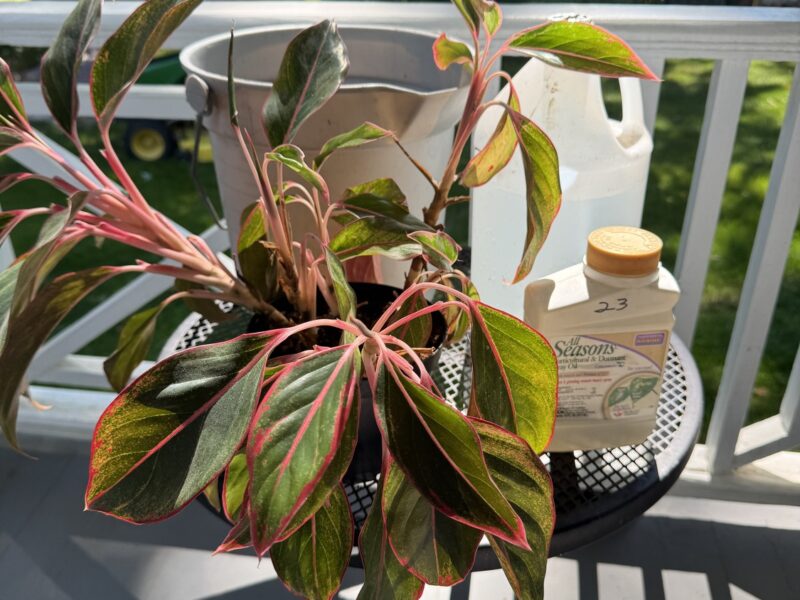

If you’re into houseplants this is your golden hour. For the next several weeks you have a chance to inspect your plants for insects, damage and their general health and if necessary, and this is where things are golden, take them outside and give them some TLC. No, no sun, but a complete inspection before they go back inside for the cooler months. And once inside all the pesky problems they may have are much harder to deal with.
In order to do a good job at this you’ll need to know what to look for and what to do if you find problems. The first tool is a 10x magnifying loupe. You can find these on Amazon for less than $20. However, once you have one it’s incredibly easy to lose. My solution is to tie a string or strap to the loupe that shows up when you drop it. Most of the loupes, also called jewelers loupes, have a small slot that you can run a string through, making the attachment fairly simple.
But what do you do with this loupe? You can’t expect to inspect every inch of your plants with it but it does come in handy when you think you’ve found a problem and need to confirm it. The next question is, what are you looking for?
Mealy bugs, aphids, scale and spider mites! These are the four you absolutely positively need to look for now because you can treat the plants outdoors from now through late September. It’s not impossible to do this in the dead of winter but trust me, now is the best time. It’s also a good time to just give your plants a bath or shower to wash off the dirt and grime that can accumulate on the foliage while the plants are indoors even in the most immaculate Hamptons homes.
Do this in on a sunny and warm day, but not in the sun. This will allow the plants to dry quickly so they can be moved back indoors. Whatever you do, don’t put the plants in full sunlight because the sun will be much more intense outdoors than it is inside going through glass, roof overhangs and other things that can block or dull the sunlight. But, before the shower, do your inspection.
Starting from the top of the plants closely inspect both the tops and bottoms of the leaves. Look for small white specs (pinhead and smaller) that can be a little cottony as these will most likely be immature mealy bugs. Larger mealybugs can look like the tip of a cotton swab, and unlike the kids, the adults are immobile and harder to treat. Unlike some of the other insect problems the mealybugs can’t simply be washed off.
Next look for scales. These are related to mealybugs but are smaller and brown to tan in color. Young scale is mobile and can move around as can the mealybugs. Mature scale is somewhat hard and can appear as a raised bump, scar or scab.
In your home you never want your houseplants touching each other as these two insects can simply walk form one leaf over to the next one. Neither of these fly. This raises the question, if you buy a plant that seems to be “clean,” how can these bugs show up months or even a year later if they aren’t in contact with other plants and these insects can’t fly?
Keep in mind that very young scale and mealy bugs are easy to overlook. In addition they always seek to hang out in cracks, cervices or in any nook and cranny on the plants stems and branches. You see them as they mature and become more obvious, but the trick to long-term control is to catch them early.
Aphids, on the other hand, are mobile and some can fly, especially females looking to lay eggs or start a new colony. Aphids are social insects, and you’ll rarely find just one. When you do find several they can be in clusters of five to 10 and if you carefully nudge one, all of them will react. Not as frequently found on houseplants as other insects, they prefer to feed on buds and flowers. Most will be green, but they can be other colors and unlike the eight-legged mealybugs and scales aphids have only six legs. In fact, of all the houseplant insects that we deal with, only the aphids are true insects. They are among the easiest to control and manage, but if you keep your houseplants outdoors in the summer they have a much higher chance of being infected than those that are home inside.
The fourth demon is the two-spotted spider mite, or 2SS. These are tiny, and most gardeners don’t even see them until they see their damage. They have needle-like mouthparts that they insert into the plant cell and suck out the living matter that sustains them. It’s this feeding that results in the yellowing, or stippling, of the leaves. Often the first sign of damage is a mottling of the foliage or the stippling. The second thing you might notice is very fine webbing on or under the foliage or around a group of leaves. In this case you will want to get the entire plant into a plastic bag before you take it outside and this will keep the mites from getting blown around the house on the slightest wisps of moving air.
OK, so you’ve got one or more of these. Now what? DO NOT use your garden insecticides. You’ll find that plain old water can be used in some cases, but light horticultural oil and neem oil will be your best friends here. If you’ve confirmed you have bugs, get the plant outside and treat it there.
In the case of spider mites, the simplest but not the most effective treatment is fine but forceful sprays of water from a hose, shower or spray bottle. This just washes the mites off, and that will at least reduce the adults. But the water may not wash off the eggs, which means a repeat infection as the eggs continue to hatch. If the plant is small enough you can invert it and dunk it in a 2-gallon pail containing SunSpray, or another a very light horticultural oil. You need to make sure that all the plant surfaces are covered, and if the plant won’t fit in a bucket use a small sprayer, but again, cover the leaves (top and bottom) and the stems and branches down to the soil. Keep the plant out of any sunlight so it doesn’t burn. When the oil dries bring the plant back indoors. The foliage will be shiny from the oil, but as long as it’s dry it’s OK to bring it back in. Repeat this in two weeks and you should be all set though making observations every few weeks is good insurance.
The method is pretty much the same for mealybugs and scale. Dunk when you can as this gives great coverage and otherwise spray. Follow the same regime with a follow up dunk or spray in two weeks. A fine spray mist that penetrates into the plant and covers all the surfaces is the best method other than dunking. These two bugs can be tough though because if you just leave one behind or don’t get a leaf or stem covered they’ll just return later in the winter.
Aphids are more of a seasonal problem unless you’re growing fruits or vegetables indoors. In many cases the aphids can simply be washed off, but that means constant monitoring to ensure they’re all gone. On the other hand, one treatment of a hort oil will wipe the aphids out until next year.
And before you spray or dunk make sure your plant is not sensitive to what you’re using. Just about any hairy-leaved (tomentose) plant can be as are some succulents, ferns and orchids. Do a Google search on your plant and include the phrase ‘horticultural oil” to see if there’s a sensitivity issue. Blue or gray foliage can also indicate a plant that might be sensitive. Using alcohol on a Q-tip is often used as a method for control of mealybugs, but I guarantee you’ll miss a few. Those few will result in many, many more and a lengthy battle.
Yes, there are some plants that these insects seem endemic to, but if your houseplants come from a good shop and a good grower they have hopefully sold you an insect-free plant. Most of the issues seem to come from mass market retailers like the big box stores that hammer their vendors to keep costs down and that often means less attention to insects during production.
One other thing. There are others who will harm your plant and you may never see them. If you’ve had your plant outdoors you can pick up snails and slugs. Inspect the undersides of your pots, and if you can pop your plant out of the pot look for them on the outer edge of the soil. I’ve also had instances where I just couldn’t figure out what was chewing on a plant’s leaves. In that case it was a beetle that lived in the pot and only emerged at night to feed on the leaves. Something to keep way back in your mind and memory.
Remember to do regular inspections. Never let your plants touch each other. When buying new plants keep them isolated for a month or two while you monitor them for potential invaders. And as the proverb says, “Be wary of friends baring gifts,” especially when they’re plants. The worst plants for houseplants in terms of insect issues? Miniature roses (mites and aphids), gardenias (spider mites) and hibiscus (spider mites, mealybugs and aphids). Kept growing.
And speaking of houseplants, do any of yours need repotting? Signs are foliage dropping only from the bottom and plants needing water several times a day. It’s not the ideal time for repotting, but it’s much safer and easier doing this now, outdoors, than in the cramped bathroom or kitchen in January, when you can actually damage the plant from a winter repotting. Don’t use a potting soil with “built in” fertilizer and don’t feed the repotted plants other than some very lean late-season feedings.
 More Posts from Andrew Messinger
More Posts from Andrew Messinger